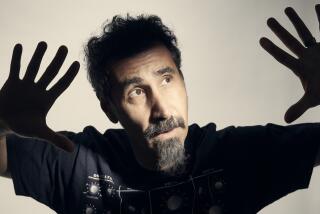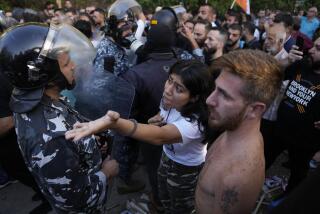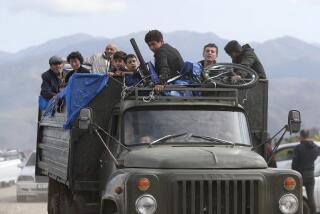Armenian Leader Seeks to Update Ancient Faith
ISTANBUL — Worried about the spread of evangelists, a division in his own ranks and what he sees as a lukewarm flock in Southern California, the new leader of Armenian Orthodox Christians says he is setting out to update his faith.
In a recent interview during a rare visit to Turkey, Karekin I said he will open a debate on abortion and the ordination of women in a family of Orthodox churches better known for monastic and mystic traditions.
Much of his focus on contemporary issues has ancient roots, as he tries to repair a schism dating back more than 16 centuries.
But one of the first goals of Karekin I, who was named the church’s catholicos, or supreme patriarch, a year ago, is to strengthen ties between Armenians and their homeland.
With a see that includes a complex, politically divided diaspora and a base in the fledgling nation of Armenia, an ex-Soviet republic, Karekin I is calling for help from the 350,000 residents of Armenian heritage in the Los Angeles area.
“Our Armenian community has to give a more committed expression to their solidarity with the Armenian church and state of today,” said the catholicos, who visited the Southland in February.
“A diaspora without a mainland does not have much chance to exist. We have been dreaming through all our history of becoming independent. This should be responded to by the diaspora, including the California community,” he added.
*
Karekin said he believes many in the diaspora have been misled about the true situation in Armenia, whose 3.3 million people are struggling to overcome the effects of a devastating 1988 earthquake and the blockades and refugees resulting from a war with Azerbaijan over the enclave of Nagorno-Karabakh.
“They should be ready to cut from their extravagance, to be more sober in their ways, and to share with their needy brothers and sisters in Armenia,” Karekin I said of Armenians living abroad. “They should visit. . . . This is the time of rebuilding a new infant state.”
Intense political differences plague Armenia. One is over the role of the radical nationalist Dashnak party. Another is the division of the Armenian church during the Cold War into two administrative parts, one based in Beirut and formerly broadly backed by the U.S., another based in Etchmiadzin, Armenia, and formerly backed by Moscow.
The Oxford-educated Karekin I, 64, seems ideally placed to reunite the Armenian church, having been patriarch in Beirut for 18 years before he was elected in Etchmiadzin to become the Supreme Patriarch and Catholicos of All Armenians.
*
Dealing with the Dashnaks is a ticklish proposition. The century-old party still dominates the diaspora and the Beirut church, and its radical positions have led to its ban in independent Armenia. However, the party still runs the breakaway administration in Nagorno-Karabakh, calling for the territory’s recognition as a fully independent state.
Karekin I, the son of refugees from the World War I massacres of between 800,000 and 1.5 million Armenians in the last years of the Ottoman Empire, said he supports the Nagorno-Karabakh struggle for “full autonomy and security” but not independence.
One of Karekin I’s aims is to push ahead with plans to consolidate the broader Orthodox family of churches in talks with Ecumenical Patriarch Bartholomew, who heads the Eastern Orthodox branch, including more than 16 autonomous churches in the Balkans, Russia and what is left of the Greek community in Istanbul. Karekin I heads the so-called Oriental Orthodox branch, which groups the Armenians, the Syriacs, the Copts, Indians and Ethiopians.
The Orthodox churches of the east split from the Roman Catholic Church in the west in 1054 over a doctrinal question and a dispute with the pope in Rome. But the Orthodox had already suffered several schisms themselves. The Armenians broke away in 451 at the Council of Chalcedon over how to define the nature of Christ.
Chalcedon is now called Kadikoy, a busy suburb of Istanbul that Karekin could see from his hotel window overlooking the Bosporus waterway. The catholicos came here at the invitation of the Armenian and Greek patriarchates of Constantinople.
“The basic ground for unity before Chalcedon could be re-created in our life today, hopefully before the year 2000,” he said. “The content of our dialogue with the Eastern Orthodox is not just Christology and doctrine, but factors of life, the moral and the spiritual. What is the impact of sects, why are they coming again to the life of the people? What is lacking? Why are we not living and making an impact on the life of young people?
“It’s no longer a question of the formulation of faith but faith itself,” Karekin I said.
He and Bartholomew have already agreed on many theological points. This fall, they will convene a committee to start discussing issues such as abortion and the ordination of women. Armenian sources said Karekin I does not necessarily believe such ideas are good ones, but he does think they should be discussed.
“The Armenian parliament, for instance, has legalized abortion. The church does not have a ready statement on this, since such discussions were banned in Soviet times,” one Armenian bishop said.
“The only demand for women priests is in the Armenian church in America,” he added. “There is no such demand in the Middle East. But from very early times, the Armenian church has been the only one that has women serve on the altar as full deaconesses.”
One aspect of the modern world brings a glint of anger into Karekin I’s eyes: proselytism, or missionary work in his religious community by evangelical sects.
Some of these groups “use material ways to take advantage” of church members, Karekin I said. One such missionary “told me he had come to preach of Christ,” he added. “I told him, ‘What do you think we’ve been doing for the past 17 centuries? You do not come to preach Christ. You have come to preach yourself.’ ”
More to Read
Sign up for Essential California
The most important California stories and recommendations in your inbox every morning.
You may occasionally receive promotional content from the Los Angeles Times.










